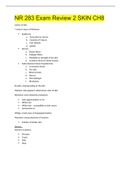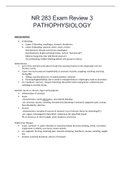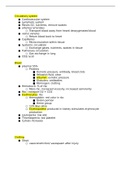NR 283 (NR283)
Chamberlain School Of Nursing
Page 4 out of 35 results
Sort by

-
NR 283 Exam Review 2 SKIN CH8
- Exam (elaborations) • 17 pages • 2022
-
- $14.00
- + learn more
Layers of skin: *varies in layer of thickness • Epidermis a. Avascular/no nerves b. Consists of 5 layers c. Hair follicles d. glands • Dermis a. Elastic fibers b. Collagen fibers c. Flexibility & strength of the skin d. Contains nerves & blood vessels • Subcutaneous tissue (hypodermis) a. Connective tissue b. Fat cells c. Blood vessels d. Nerves e. Macrophages f. fibroblasts Keratin: waterproofing of the skin Melanin: skin pigment- determines color of skin Albinisim: l...

-
NR 283 Exam Review 3 PATHOPHYSIOLOGY
- Exam (elaborations) • 14 pages • 2022
-
- $13.00
- + learn more
Gastrointestinal • GI bleeding a. Upper GI bleeding: esophagus, stomach, duodenum b. Lower GI bleeding: jejenum, ileum, colon, rectum Hematemesis: bloody vomit (from esophagus) Hematochezia: bright-red blood (colon, rectum “hemmoroid”) Melena: burgundy color (old blood; jejunum) Occult bleeding: hidden bleeding (blood cells present in feces) Hiatal Hernia: • part of the stomach protrudes through the opening (hiatus) in the diaphragm into the thoracic cavity • Cause: too muc...

-
Chamberlain College of Nursing PATHO NR283 exam 2 review
- Exam (elaborations) • 57 pages • 2021
-
- $12.49
- + learn more
Circulatory system ● Cardiovascular system ● Lymphatic system ● Moves O2, nutrients, remove wastes ● arteries/ arterioles ○ Transport blood away from heart/ deoxygenated blood ● veins/ venules ○ Return blood back to heart ● Capillaries ○ Microcirculation within tissue ● Systemic circulation ○ Exchange gases, nutrients, wastes in tissue ● Pulmonary circulation ○ Gas exchange in lung ● CO2/ acid Blood ● plasma/ 55% ○ Proteins ■ Osmotic pressure, ...

-
NR 283 Pathophysiology(VERIFIED)
- Exam (elaborations) • 3 pages • 2021
-
- $8.19
- + learn more
Pathophysiology involves the study of: a. the structure of the human body. b. the functions of various organs in the body. c. functional or structural changes resulting from disease processes. d. various cell structures and related functions. 2. The number of new and old or existing cases in a specific population within a specified time period is called: a. prevalence. b. occurrence. c. incidence. d. abstinence. 3. The term prognosis refers to the: a. period of recovery and return to a normal st...

Do you wonder why so many students wear nice clothes, have money to spare and enjoy tons of free time? Well, they sell on Stuvia! Imagine your study notes being downloaded a dozen times for $15 each. Every. Single. Day. Discover all about earning on Stuvia


